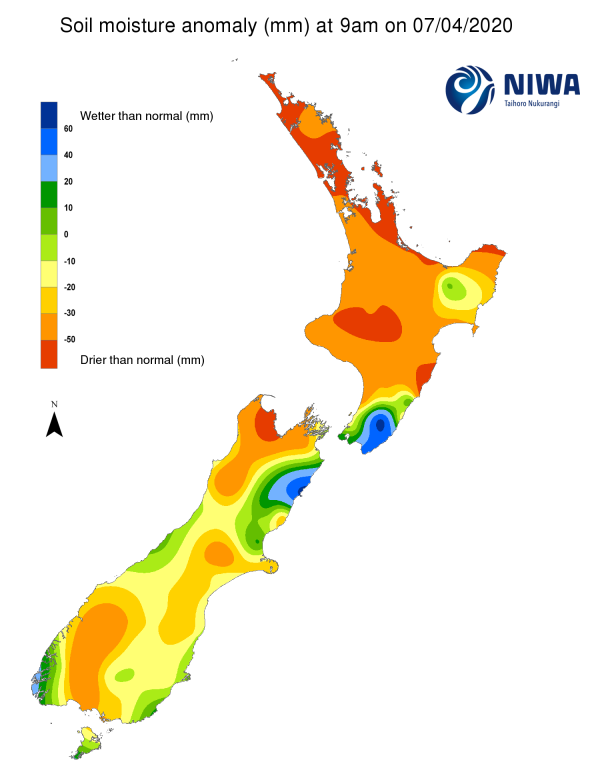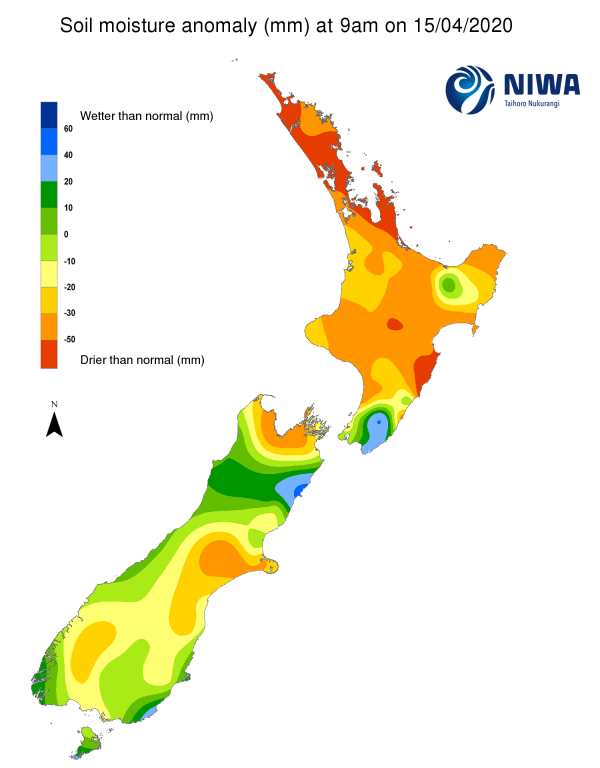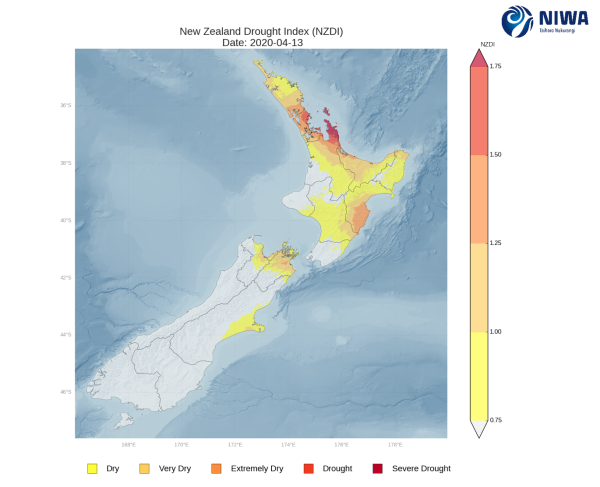A weekly update describing soil moisture patterns across the country to show where dry to extremely dry conditions are occurring or imminent. Regions experiencing significant soil moisture deficits are deemed “hotspots”. Persistent hotspot regions have the potential to develop into drought.
Facts: Soil Moisture
In the North Island, substantial rainfall of 30 mm or more was observed in the past week across many western areas, the Central Plateau, eastern Bay of Plenty, and parts of Gisborne. Many other locations saw moderate falls of 15-25 mm, although minimal rainfall of less than 10 mm was observed in much of Hawke’s Bay and Wairarapa. This resulted in small to moderate soil moisture increases in the same areas that saw the heaviest rainfall, while little change was observed in the upper North Island. Meanwhile, soil moisture decreases occurred from Central Hawke’s Bay to Wellington. The driest soils across the North Island, when compared to normal for this time of the year, are located across much of the upper North Island and Central Hawke’s Bay. Meanwhile, the wettest soils for this time of the year are located in southern Wairarapa. The New Zealand Drought Index (NZDI) shows that severe meteorological drought remains in place across much of the Coromandel Peninsula, while meteorological drought is found in the lower Coromandel Peninsula and parts of eastern Auckland (see NZDI map).
Hotspot coverage did not change significantly in the past week, with hotspots currently found across parts of Northland and Auckland, far northern Waikato (including the Coromandel Peninsula), southern Hastings, Central Hawke’s Bay, and western Manawatu-Whanganui.
In the South Island, heavy rainfall greater than 75 mm fell across nearly all of the West Coast, with some pockets greater than 125 mm. Much of Southland also observed moderate rainfall of 30 mm or more. While Otago received up to 25 mm in places, very meagre rainfall (<10 mm) was once again observed across Canterbury and eastern Marlborough. While moderate soil moisture increases occurred across Tasman, West Coast, and the lower South Island, slight decreases were observed across much of Canterbury. The driest soils in the South Island compared to normal for this time of the year are located in Nelson, nearby parts of Tasman and Marlborough, and central Canterbury, while the wettest soils for this time of the year are found in Kaikoura. The NZDI shows that meteorological drought is no longer found in the South Island, although widespread dry soils are still present in the top of the South Island and parts of central Canterbury (see NZDI map).
The former hotspot in Nelson and nearby parts of Tasman dissipated in the past week, while in Canterbury hotspots remain in broken pockets from Banks Peninsula south to Waimate.
Outlook and Soil Moisture
In the North Island, scattered showers will occur in western areas today (16 April), with a better chance for widespread showers and isolated thunderstorms across most of the North Island on Friday and early Saturday. Some locations in the western and central North Island may receive more than 30 mm during this time. On Monday (20 April), a front dropping down from the north may deliver more moderate rainfall to parts of the upper North Island, although it is too early to determine exact locations at this time. Tuesday is likely to be more tranquil, before low pressure dropping down from the north may bring rain to the northeastern part of the island on Wednesday (22 April). Depending on where any showers and fronts set up during the next week, parts of the western and central North Island may receive rainfall totals near 50 mm, with 30 mm or more possible in the upper North Island. However, from Hawke’s Bay to Wairarapa, amounts less than 25 mm are likely.
With significant rainfall possible in parts of the North Island, many locations will likely see minor to moderate soil moisture increases during the next week. However, it is possible that no change or even slight decreases will occur from Hawke’s Bay to Wairarapa. Therefore, the hotspot in this region may slightly strengthen in the next week, although other North Island hotspots are likely to weaken at least slightly.
In the South Island, a series of fronts will bring significant rainfall to the West Coast between Friday and Sunday (17-19 April), with moderate amounts for the lower South Island. However, rainfall amounts across Canterbury and Marlborough will once again only be minimal. During early to mid next week, developing high pressure over the South Island will result in mostly if not completely dry weather. Total weekly rainfall in the next week may exceed 100 mm in parts of the West Coast, with perhaps 25-30 mm in the lower South Island. However, meagre rainfall is again expected in eastern areas, where Canterbury and Marlborough may receive less than 10 mm.
Additional soil moisture increases will be possible along the West Coast due to significant rainfall, while minimal changes are expected in Otago and Southland. However, additional soil moisture decreases are likely to occur in the eastern South Island, resulting in the hotspots there increasing in strength and size.
Background:
Hotspot Watch: a weekly advisory service for New Zealand media. It provides soil moisture and precipitation measurements around the country to help assess whether extremely dry conditions are imminent.
Soil moisture deficit: the amount of water needed to bring the soil moisture content back to field capacity, which is the maximum amount of water the soil can hold.
Soil moisture anomaly: the difference between the historical normal soil moisture deficit (or surplus) for a given time of year and actual soil moisture deficits.
Definitions: “Extremely” and “severely” dry soils are based on a combination of the current soil moisture status and the difference from normal soil moisture (see soil moisture maps)
Hotspot: A hotspot is declared if soils are "severely drier than normal" which occurs when Soil Moisture Deficit (SMD) is less than -110 mm AND the Soil Moisture Anomaly is less than -20 mm.
Pictured above: Soil Moisture Anomaly Maps, relative to this time of year. The maps show soil moisture anomaly for the past two weeks.
New Zealand Drought Index (NZDI)
As of 13 April, the New Zealand Drought Index (NZDI) map below shows that meteorological drought remains in place across parts of eastern Auckland and far northern Waikato, particularly in the Coromandel Peninsula where severe meteorological drought is found. Meteorological drought is no longer found in the South Island. Please note: some hotspots in the text above may not correspond with the NZDI map. This difference exists because the NZDI uses additional dryness indices, including one which integrates the rainfall deficit over the past 60 days. Changes are therefore slower to appear in the NZDI compared to soil moisture anomaly maps that are instantaneously updated.




